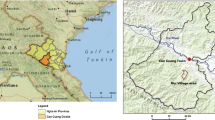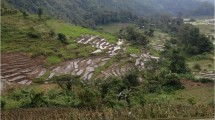Abstract
There is a need to assess climate change mitigation opportunities in forest sector in India in the context of methodological issues such as additionality, permanence, leakage and baseline development in formulating forestry mitigation projects. A case study of forestry mitigation project in semi-arid community grazing lands and farmlands in Kolar district of Karnataka, was undertaken with regard to baseline and project scenario development, estimation of carbon stock change in the project, leakage estimation and assessment of cost-effectiveness of mitigation projects. Further, the transaction costs to develop project, and environmental and socio-economic impact of mitigation project was assessed.
The study shows the feasibility of establishing baselines and project C-stock changes. Since the area has low or insignificant biomass, leakage is not an issue. The overall mitigation potential in Kolar for a total area of 14,000 ha under various mitigation options is 278,380 t C at a rate of 20 t C/ha for the period 2005–2035, which is approximately 0.67 t C/ha/year inclusive of harvest regimes under short rotation and long rotation mitigation options. The transaction cost for baseline establishment is less than a rupee/t C and for project scenario development is about Rs. 1.5–3.75/t C. The project enhances biodiversity and the socio-economic impact is also significant.

Similar content being viewed by others
Notes
Earthen embankment constructed to retain water or for separating one farm from the other.
References
Brown S, Sathaye J et al (1996) Mitigation of carbon emissions to the atmosphere by forest management. Commonw Forest Rev 75(1):80–91
Champion HG, Seth SK (1935) Forest types of India. Forest Research Institute, Dehra Dun
FSI (1996) Volume equations for forests of India, Nepal and Bhutan. Forest Survey of India, Ministry of Environment and Forests, Government of India
Hamburg SP (2000) Simple rules for measuring changes in ecosystem carbon in forestry-offset projects. Mitigation and Adaptation Strategies for Climate Change
IPCC (1996) Revised 1996 IPCC Guidelines for national greenhouse gas inventories: reference manual. Section on land use change and forestry sector, Cambridge University Press, Cambridge, UK
IPCC (2000) Land use, land use change and forestry. In: Watson RT, Noble IR, Bolin B, Ravindranath NH, Verardo DJ, Dokken DJ (eds), Cambridge University Press, Cambridge
IPCC (2003) IPCC good practice guidance for LULUCF sector. Intergovernmental Panel on Climate Change. Cambridge University Press, Cambridge, UK
Lile R, Powell M, et al (1998) Implementing the clean development mechanism: lessons form the U.S. private sector participation in activities implemented jointly. Discussion Paper 99-08, Resources for the Future, Washington DC
Ravindranath NH, Sudha P et al (2001) Forestry for sustainable biomass production and carbon sequestration in India. Mitig Adapt Strat Global Change 6:233–256
Ravindranath NH, Somashekar BS (1995) Potential and economics of forestry options for carbon sequestration in India. Biomass Bioenerg 8:323–336
Sathaye J, Ravindranath NH (1998) Climate change mitigation in the energy and forestry sectors of developing countries. Ann Rev Energ Environ 23:387– 437
Schwarze1 R, Niles JO et al (2002) Understanding and managing leakage in forest-based greenhouse-gas-mitigation projects. Phil Trans R Soc Lond http://www.ghgprotocol.org/docs/carbon-leak.pdf
Acknowledgements
This work was supported by the U.S. Environmental Protection Agency, Office of Atmospheric Programs through the U.S. Department of Energy under Contract No. DE-AC02-05CH11231. Disclaimer: The views and opinions of the authors herein do not necessarily state or reflect those of the United States Government or the Environmental Protection Agency. We thank Jayant Sathaye and Ken Andrasko for their contribution at various stages of development of this study. We also thank Neeta Hooda, Mohit Gera and all other scientists of ICFRE for their suggestions. We thank the Karnataka Forest Department, particularly Swaminath M.H., Rangaswamy, Nagaraj and several Range Forest Officers of Kolar. This project was conducted under a collaborative programme of USEPA-Ministry of Environment and Forests.
Author information
Authors and Affiliations
Corresponding author
Rights and permissions
About this article
Cite this article
Ravindranath, N.H., Murthy, I.K., Sudha, P. et al. Methodological issues in forestry mitigation projects: a case study of Kolar district. Mitig Adapt Strat Glob Change 12, 1077–1098 (2007). https://doi.org/10.1007/s11027-006-9065-2
Published:
Issue Date:
DOI: https://doi.org/10.1007/s11027-006-9065-2




